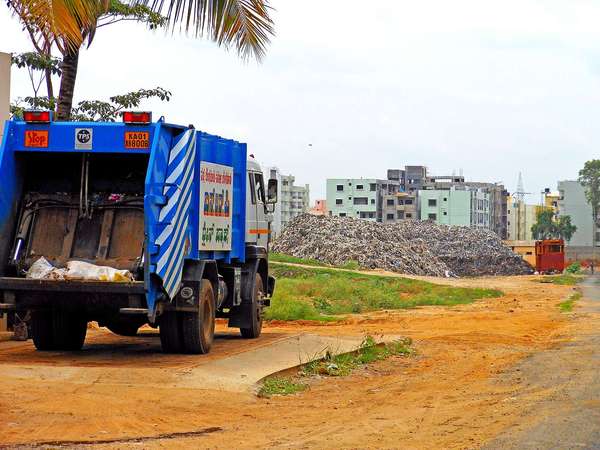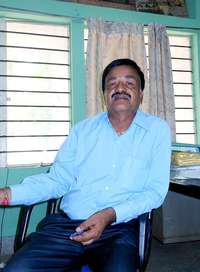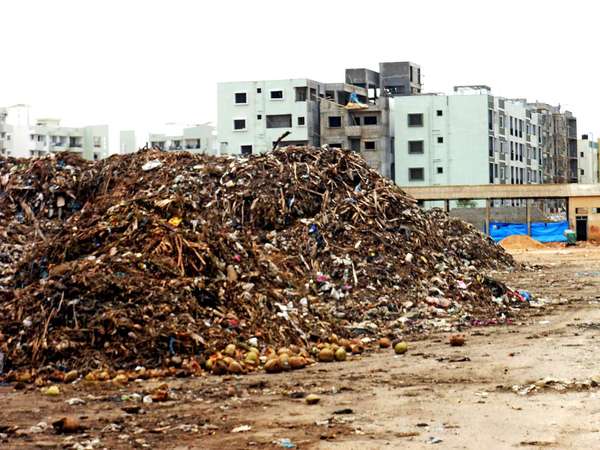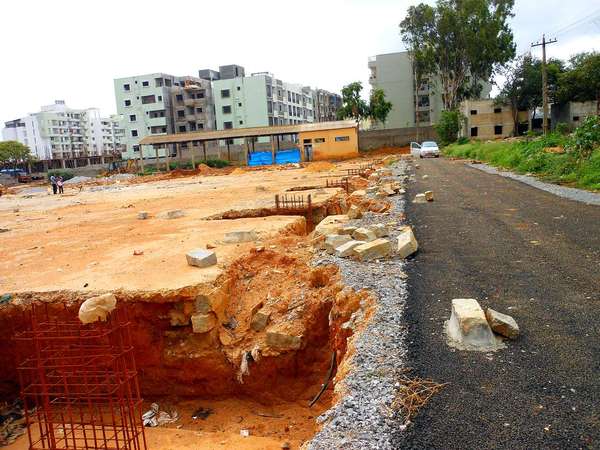KCDC will manage one lakh tons of accumulated (old) waste along with the additional waste after the arrival of the new processing units. Pic: Nikita Malusare
Earlier this year, the Bruhat Bengaluru Mahanagara Palike tried to send vegetable waste from markets across Bengaluru, to goshalas (dairies). The intention was good, but goshalas refused this waste. The reasons being many, such as the bad quality of waste and the problem with logistics, BBMP could not convince goshalas to accept this waste.
This was when the long-forgotten Karnataka Compost Development Corporation came into picture. The BBMP diverted the vegetable waste from markets to Karnataka Compost Development Corporation (KCDC), near HSR Layout.
BBMP has started sending KCDC around 100 tons of vegetable waste a day, from Madivala and city market, by June 2013. Thus the KCDC came back in the limelight, trying to do its bit to improve the waste management scene in Bangalore.
Advisor to KCDC, Venkoji Rao has seen the corporation grow since 1975. Pic: Nikita Malusare
One among thirteen in India
The Karnataka Compost Development Corporation is one of thirteen such plants in India constructed in 1975, based on World Health Organisation’s technology as per the directions of Government of India to 22 states and the recommendation of Sivaraman Committee.
This was India’s first public sector unit involved in Municipal Solid Waste management that has successfully managed to compost city waste. This initiative was funded by Karnataka Agro Industries Corporation (51%), BBMP(24.5%) and Karnataka State Co-operative Marketing (24.5%)
“KCDC has made use of low cost and indigenous machines that can work with unsegregated waste,” says Venkoji Rao, Advisor to the KCDC.
Without any budgetary support, the KCDC has managed its activities with revenues from the sale of manure produced through aerobic and vermin-composting.
The manure produced is sent to the Department of Agriculture and is sold at 50 percent subsidy to farmers across Karnataka and India.
Old garbage, old problems
The KCDC also has the responsibility of treating around a lakh tons of mixed waste accumulated over last few years.Around 1000 tons of mixed waste was being sent daily from 2005, but KCDC could not process it all in time. In 2008, KCDC stopped accepting waste from the BBMP as the residents of the H S R Layout protested over unbearable stink and stench produced from over five lakh tons of unsegregated waste.
Venkoji Rao says, “we had accepted waste (way) over our capacity. Composting activities were going on and it is still done.”
Unsgregrated waste is spread over 30 acres of the land on the KCDC premises. Pic: Nikita Malusare
Troubled neighbourhood
However, the residents living near KCDC spread over 29 acres of land at Singasandra still complain about being troubled by the flies and mosquitos day and night.
In a lemon green color house, standing right adjacent to the KCDC’s compound wall lives Gulab Khan, 48, with eight members in her family. Her living room’s floor was filled with small black flies that fluttered when any one passed by the room.
She says, “I cannot keep the windows and doors open. We are constantly harassed by the flies.”
Citizen Matters asked the ex-Managing Director of KCDC, Basavaiah C, who served at the KCDC for eight years – the longest serving MD till date and now a columnist on environment topics.
He says, “The reason why people around there are still facing the problem is the ‘historical’ waste that still occupies the land. Once that waste gets treated, the problem will be solved. ”
Construction of 8-meter high sheds, compound walls, and a direct connecting road is in process. Pic: Nikita Malusare
Sheds still in the making
KCDC proposed to BBMP in February 2013, a plan for an 8-meter high shed on concrete slabs on the Kudlu site. BBMP drafted a project to be executed in two phases. Phase I covers a one acre space, which is due to be completed by July. Phase II will cover two acres of land.
These sheds are required to protect the garbage from rain which creates excess leachate and causes stench. Even though KCDC has a 50 litre leachate tank, it is impossible to stop excess leachate from flowing into Somasundarapalya tank during rainy season.
But the groundwork of the shed is still in process. The KCDC is worried about the delay as the rains have already started. A BBMP engineer on condition of anonymity said, “as and when it rains, labourers remain absent, because of which there is a delay in the work. But we aim to complete the compound walls, sheds and road work by this July.”
The high compound walls to be constructed around KCDC will also obstruct the view of the dumped garbage and the residents will not have to see it from their homes.
A direct road from HSR Layout to KCDC will be built soon, which would speed up the transportation of garbage to the site.
Tons of plastic waste produced as waste during composting is still waiting to see recycle units. Pic: Nikita Malusare
KCDC’s downtime
The KCDC’s manure production reached an all time high of 20,151 million tons in 2004-2005. But annual reports show a gradual decline in its production and sale of manure from 2005 to 2013 and related losses.
Basavaiah says, “The unsegregated waste that surpassed the capacity of the plant (due to the 2005 garbage crisis) and limited funds available for the maintenance, resulted in lower production as the KCDC does not have budgetary support.” From 2005 to 2008, the production of the manure dropped by 72%, and dropped by 27 per cent (7,528 million tons) in 2011.
Along with the production, profit of the company too saw its own ups and downs. From Rs.1.29 Lakhs in the year 2000, it had its highest earning in the fiscal year 2003-04, Rs.6.85 Lakhs.
Rao also blames the poor demand for organic manure by farmers. Application of organic manure requires labour. Chemical fertilisers that require less labour and quick results are more in demand.
‘Difficult to work in night’
In 2008, KCDC’s compound had huge mounds of unsegregated garbage. Residents of HSR Layout Sector II protested theabout foul odour and even filed a PIL in this regard. The High Court ruled that since KCDC was built in 1975 much before the houses came up, people cannot stop its functioning. But it asked KCDC to take all precautionary steps in order to protect the residents. The KCDC then stopped accepting garbage from BBMP.
The High Court had directed KCDC to work in three shifts of eight hours to process the accumulated 1.65 lakh tons of garbage. Court also ordered them to recruit any additional labour required for the same until the new plant arrives. (Src:The Hindu)
However the KCDC continues to work in two shifts only: from morning 9 to evening 6. Technical manager, A Muniraj, points out at the lack of lighting at the site and sharp objects like iron filling and nails left scattered, explaining why it is difficult to work once the sun sets.
On being asked whether this amounts to contempt of court, Basavaiah said: “It is indeed a contempt of court order, but I don’t know the reason for it. If KCDC is not able to oblige it, it should have given in writing to court the reason for its incapability to adhere to it.”
New life for KCDC
The KCDC is now set to double its processing capacity by setting up another plant. The new unit is supposed to come up on the land adjacent to the present site and will process another 200 tons.
Equipment is expected to arrive in a couple of months. The KCDC will also set up another plant of 600 tons capacity at a cost Rs 4 crores at Chikkanagamangala (off Sarjapur Road), the project was sanctioned by BBMP ex–commissioner Siddaiah and has been a controversial topic at the council meetings.
Even after 37 years of its establishment, Karnataka Compost Development Corporation has been unable to scale up to meet the demand for Municipal Waste Management, the reasons being many. Basavaiah says, “Now the BBMP is willing to support KCDC as it has recognised its importance.”
KCDC plans to initiate a training center at the Haralukunte site at a cost of Rs.150.29 lakh with training programmes to be open to all. This programme will include demonstration and training on how to segregate and vermi-compost waste. This project is still awaiting for its approval from BBMP.
Delighted greens
The revival of the KCDC has been music to many ears. Member of the Environment Support Group, Bhargavi S Rao, trustee and Co-ordinator of educational programmes, expressed her happiness: “Definitely KCDC will be able to manage the waste that it will receive. Instead of having unscientific landfill, a compost is any time reliable. Also the compost thus produced has proven to be very useful in developing kitchen or urban gardens.”
Related Articles
Jayanagar gets waste converter
Understanding how to segregate waste
Hotel waste to be used in biogas production
How we started segregating our waste





There is already lot of waste scattered there on KCDC kudlu site and again BBMP started sending more waste even though they know that hundreds of houses are constructed nearby. I think they don’t care about people that they should not start sending new waste as already lot of tons laying there and basic setup is not there. Wakeup nearby people it is not bearable. Fight for this.
The article itself quotes that the authorities of KCDC themselves admit the contempt of court by not implementing the directives of the High Court. Not sure what else can change the system. Neither the people representatives nor the law enforcement authorities are serious about what is justified. Hope someone invokes the PIL again to bring it to the notice of the Honorable HIgh Court regarding this contempt of court and violation of the order / suggestions thereof.